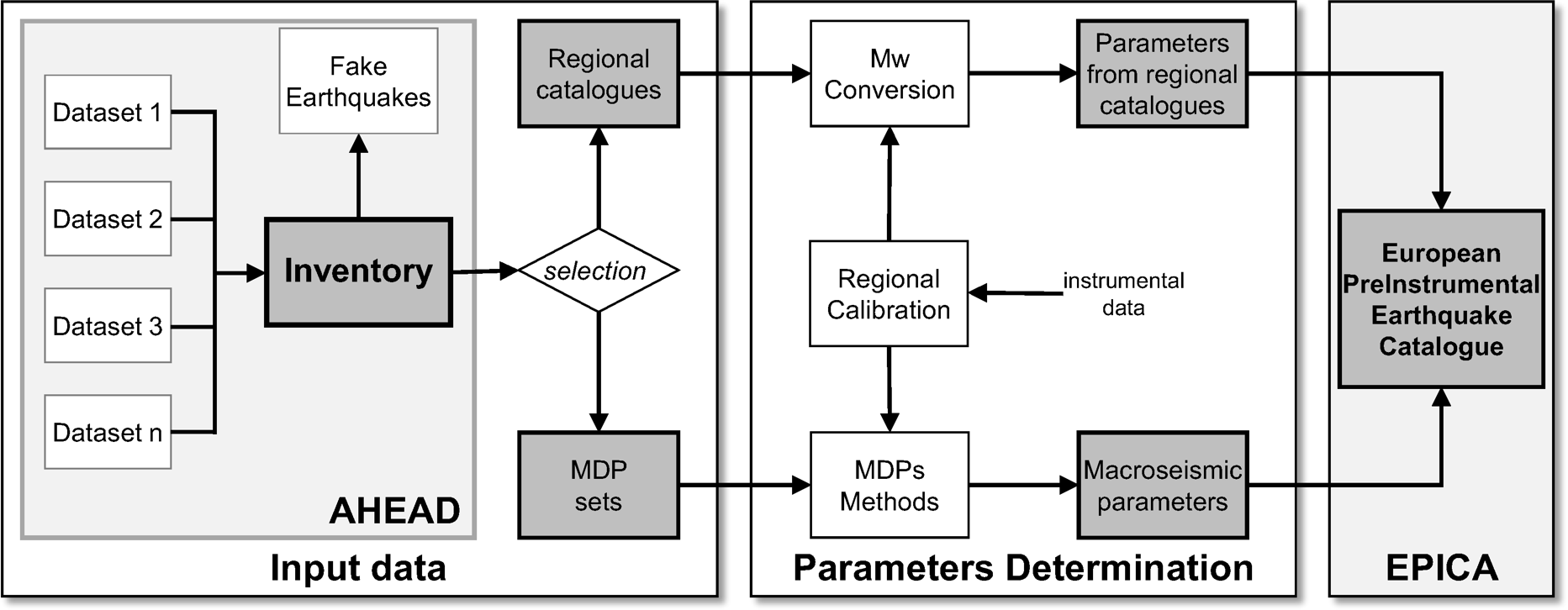|
EPICA
|
European PreInstrumental Earthquake CAtalogue
|
EPICA v.1.1 - Data Quality Assurance
The European PreInstrumental Earthquake CAtalogue EPICA v1.1 is the 1000-1899 seismic catalogue compiled for for the European Seismic Hazard Model 2020 (ESHM20) in the framework of the SERA Project (Seismology and Earthquake Engineering Research Infrastructure Alliance for Europe) within European Union's H2020 research and innovation programme. EPICA takes into account the knowledge of European preinstrumental seismicity gathered and presented in AHEAD, the European Archive of Historical Earthquake Data. EPICA is the update of the SHARE European Earthquake Catalogue SHEEC 1000-1899 with which shares the same principles of transparency, repeatability, and continent wide harmonisation of data and procedures as described in Stucchi et al. (2013) and Rovida et al. (2022), and summarised in the figure below. The compilation procedure includes different steps for data quality control and assurance. The catalogue is downloadable, under a CC BY 4.0 licence, from a dedicated web portal and through the AHEAD web services for event parameters. These web services are compliant with the FDSN event, OGC WFS, and OGC WMS standards, making EPICA data accessible by the EPOS ICS portal.

Compilation procedure of EPICA version 1.1 (from Rovida et al., 2022)
- Step 1 - Data source investigation. Data sources inventoried and published in AHEAD are investigated and compared on the basis of the different types of information available for each earthquake. In particular, the data sources are divided into two types: (1) data sources providing macroseismic intensity data and (2) data sources providing epicentral parameters from regional catalogues.
-
Step 2 - Data source selection.
The data source most representative of the knowledge of each earthquake is selected from both data sources (1) and (2), disregarding national boundaries and according to their availability. In the presence of multiple data sources for the same earthquake, the selection of the preferred data source (1) considers the characteristics of the research that produced it, preferring those accompanied by thorough descriptions of the performed investigation. For multiple data sources (2) for the same earthquake, preference is given to parametric catalogues accounting for their input information and the methods for assessing earthquake parameters. In this way, one MDP (Macroseismic Data Point) set and/or one parametric catalogue are selected for each earthquake.
Checkpoint 1
The selection of the preferred data sources is checked and validated. -
Step 3 - Determination of epicentral parameters.
Two sets of parameters, consisting of epicentral intensity, epicentral location and moment magnitude, and their uncertainties are determined for each earthquake according to the data sources selected. Parameters from data sources (1) are assessed from MDPs with published and repeatable procedures (MDP methods) regionally calibrated. For data sources (2) locations are derived from regional earthquake catalogues and moment magnitude, if not provided, is homogeneously determined from epicentral intensity.
Checkpoint 2
For each earthquake, the two sets of parameters calculated from data sources (1) and (2) are checked for their consistency with the input data and are then compared with each other. -
Step 4 - EPICA compilation.
The catalogue is compiled with the origin times for each earthquake, taken from the selected datasets, and the parameters from data sources (1) and (2). The combination of the two sets of parameters determines the final ones, obtained from the selection of the location from either data source (1) or (2), and assessing the magnitude as the weighted mean of those resulting from data sources (1) and (2), depending on their availability. Only the earthquakes with moment magnitude greater than or equal to 4.0 and/or maximum intensity 5 are selected and included in the catalogue.
Checkpoint 3
The parameters of the catalogue are compared with those of the previous parametric earthquake catalogues available in AHEAD in order to test the consistency of the results. - Step 5 - Data publication and dissemination. The event data are finally published and disseminated through OGC and FDSN-event web services, Microsoft Excel (xlsx) and OpenDocument (ods) formats and with the related detailed documentation.
Page last updated on the 28th of October 2022.